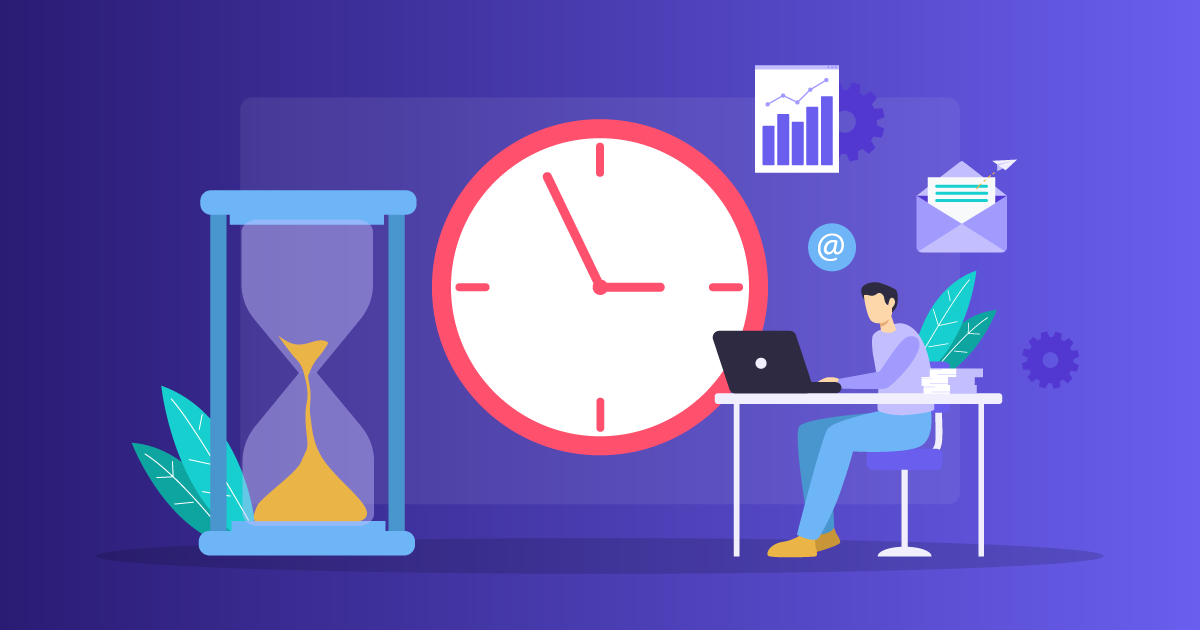Having Trouble With Being Productive? Here Is How to Find Your Most Productive Hours



Key Takeaways:
- Every individual works differently, and catering to their productivity style with effective remote work systems can help them get the most out of their work hours.
- There are many techniques you can promote to boost productivity from leveraging productivity apps to working in cycles.
- Using remote work monitoring software and task time trackers like Insightful can help you identify productivity trends in your workforce with automatic time tracking.
Read time: 6 minutes
Everyone is different.
Some people are "morning larks" who are most productive in the early hours of the day, while others are "night owls" who thrive during the night.
We experience productivity "peaks" and "valleys", and productivity isn’t something we can just turn on when we feel like it. There are times when we are highly productive, and there are times when we are not.
Just because you are not productive at certain hours does not mean that you should dismiss those hours.
Instead, you should find when you are most productive so that you can optimize those hours to achieve more. Knowing when you are your most productive will immensely help you to deal with your most challenging tasks and generally help you do more.
So, how does one determine (hint: remote work monitoring software can help) when they are at their most productive?
1. Understanding the Circadian Rhythm
Humans run a well-defined internal clock that determines our energy levels throughout the day. It is often referred to as a circadian rhythm because it tends to last about 24 hours and is supported by the Earth's rotation around the sun.
As a biological process, the circadian rhythm governs our energy levels, mood, and cognitive function. While the rhythm can vary from one individual to the next, the basic pattern remains the same: meaning it’s inevitable that we’ll all experience energy peaks and valleys throughout the day.
Capitalizing on Your Natural Rhythm
A great example of the circadian rhythm in action is the sleep-wake cycle, where a person is awake and active during one part of the day, and then they tend to relax, unwind, and eventually sleep, during the other part of the day.
Simply bringing your energy levels to your awareness, then, is an excellent starting point for identifying your opportunities for peak productivity. For example, if you always wake up groggy, and start to feel energized after 5 p.m., then you know that the evening is your time to shine.
2. Recognize Productivity Blocks
Humans move cyclically. So if you want to be your most productive and creative self, you need to figure out when you are most productive in your rhythm and sync to it.
90-120 Minute Blocks
Many studies show that our brains work best at 90 to 120-minute intervals. That’s why the Pomodoro time management method is so successful, as it acknowledges our limited capacity for focus over a long period of time. It also explains why in his groundbreaking bestseller ‘Deep Work’, author Cal Newport suggests starting with 60-90 minute productivity bursts.
After this time has passed, the brain needs to cool off.
Ultradian Cycles
These productivity blocks are called ultradian cycles. Each cycle starts when your brain is most productive and focused. As time passes, your brain's energy will slowly deplete. Even though you can continue working while having low energy, that does not mean you should. You will not be as effective as you were since your brain needs a break.
Instead of pushing yourself over your limits, you should focus on finding your personal ultradian cycles.
By knowing when you are most productive, it will be easier for you to tackle projects that require creative thinking, problem-solving, and other tasks that involve putting your brain to work. You can do your less intense brain-intense work when your brain is not at its power peak.
3. Time Logging & Reflection
The idea behind this strategy is to track your motivation, energy, and focus so that you can get a sense of when you are the most productive. The easiest way to find your most productive hours is to track how you spend your day. For this, you need a clock and a pen and paper.
How to Track Time
Start working, and after about an hour, reflect on what you have accomplished the hour before. Record your motivation, focus, and energy level for each hour that you are working. The longer you track your productivity, the more reliable your trends will be.
After you are done with work for the day, take a few minutes to reflect on what you did that day.
See if you can notice any patterns and when you are most productive, as well as when you feel a dip in your energy. Be honest when writing down how you spent your workday. Stick with logging your time for a week or two and you will have clear indicators of how your ultradian cycles work.
4. Organize Your Day Around Your Most Productive Hours
Now that you know when you are most productive, you can start planning out your day so that it is optimized for more productivity. To keep track of your time you can use a productivity time tracker app like Insightful.
Time Tracking with Insightful
With our remote work monitoring software app, you can easily measure your productivity by labeling websites and apps as productive or unproductive and using those labels and the time you tracked using them to know exactly how productive you are.
If you are running a company or managing a team, Insightful can also help you keep track of your employees' productivity. Our productivity time tracker app can also help your employees (and you!) find their most productive hours. Instead of using pen and paper and writing down what you did, you can let Insightful do that for you.
Using our intuitive productivity tagging and tracking system, you can easily figure out what you did during the day and whether or not what you did was productive.
5. Run Some Experiments
If you’re still at a loss, and you just can’t figure out when you’re most productive - we have a challenge for you.
It requires running experiments with different types of tasks and tracking your performance at various times of day.
Curious?
Let’s dive in.
First, you’re going to choose a repetitive task that requires you to concentrate. Here are several examples to get you started:
- Puzzles
- Article summaries
- Menial work task
- Crossword
- Coding
Picked one?
Ok, now try this task at various times of the day. So let’s say you chose to do a crossword, in this case, you would have a go at it first thing in the morning after you wake up, then again after lunch in the afternoon, and then once more before you go to bed at night.
After each attempt, take notes on how long it takes you to complete the crossword and how well you did. Once you’ve recorded your efforts for the whole day, you can examine the results and see what you can infer.
Chances are there’ll be a clear winner, which will shed light on when you’re at your most productive.
For even better results, repeat the same task more times throughout the day so you can pinpoint the exact hours of peak performance.
6. Leverage Productivity Apps
The productivity app market is booming these days - so why not defer to the experts in this realm?
There are tons of apps that can help you make the most of your time in various ways:
- Creating to-do lists
- Completing tasks with timers and rewards
- Competing against yourself
These are just a few techniques these apps use to help you get more out of your time.
But you can also leverage the data these apps collect to identify when you experience lapses in productivity, and how you can create a schedule that works best for you.
7. Add Physical Activity & Take Breaks
Sometimes the best thing you can do for your productivity is stop.
That’s right: stop whatever work you’re doing, and give your brain a brief respite to recover.
They say that most people can work in 40-50 minute bursts at a time, meaning that if we spend more time than that focussing on a single task it can result in diminished productivity.
With that being the case, there are two ways you can maximize your time:
- Physical activity - even if you only leave your computer for 5 minutes at a time, you have enough time to move around. Do some jumping jacks, get on a stationary bike, or walk around the space you’re in. The activity itself isn’t important, what matters is that you move and promote healthy blood flow around your body and to your brain.
- Regular breaks - every now and then it’s a good idea for your eyes (and brain) to take five and escape the screen. Regular breaks might seem like a distraction from your work, but if it helps you get more done when you sit down at your desk, it’s time well spent.
8. Seek Feedback
If all else fails, and you feel like nothing is working to improve your productivity, it might be time to seek solutions outside yourself.
Sometimes we can get so focused on ourselves and how we can improve, that we could be spending time on the wrong things without noticing it. It’s not until somebody with a fresh perspective takes a look at what we’re doing that we realize just where we’ve been going wrong.
If you work in a team, reach out to the team members who know you best and ask them if they’ve noticed anything about your productivity trends.
If not, have someone in your life take a look at how you’re spending your time and offer suggestions on different ways you could structure your schedule to optimize for productivity. It’s hard to overestimate the impact of a fresh set of eyes - especially when it comes to getting more done.
Choose Quality over Speed
Figuring out how your ultradian cycles work and finding your most productive hours can have huge benefits for you. By knowing when you are your most productive, you can easily get more work done and the work you do will likely be better.
The goal of finding your most productive hours is to be more productive and not speed up how you work. Finding your most productive hours can also help remove that nagging sense of guilt about not doing anything we all sometimes experience.

.jpg)
.jpg)
